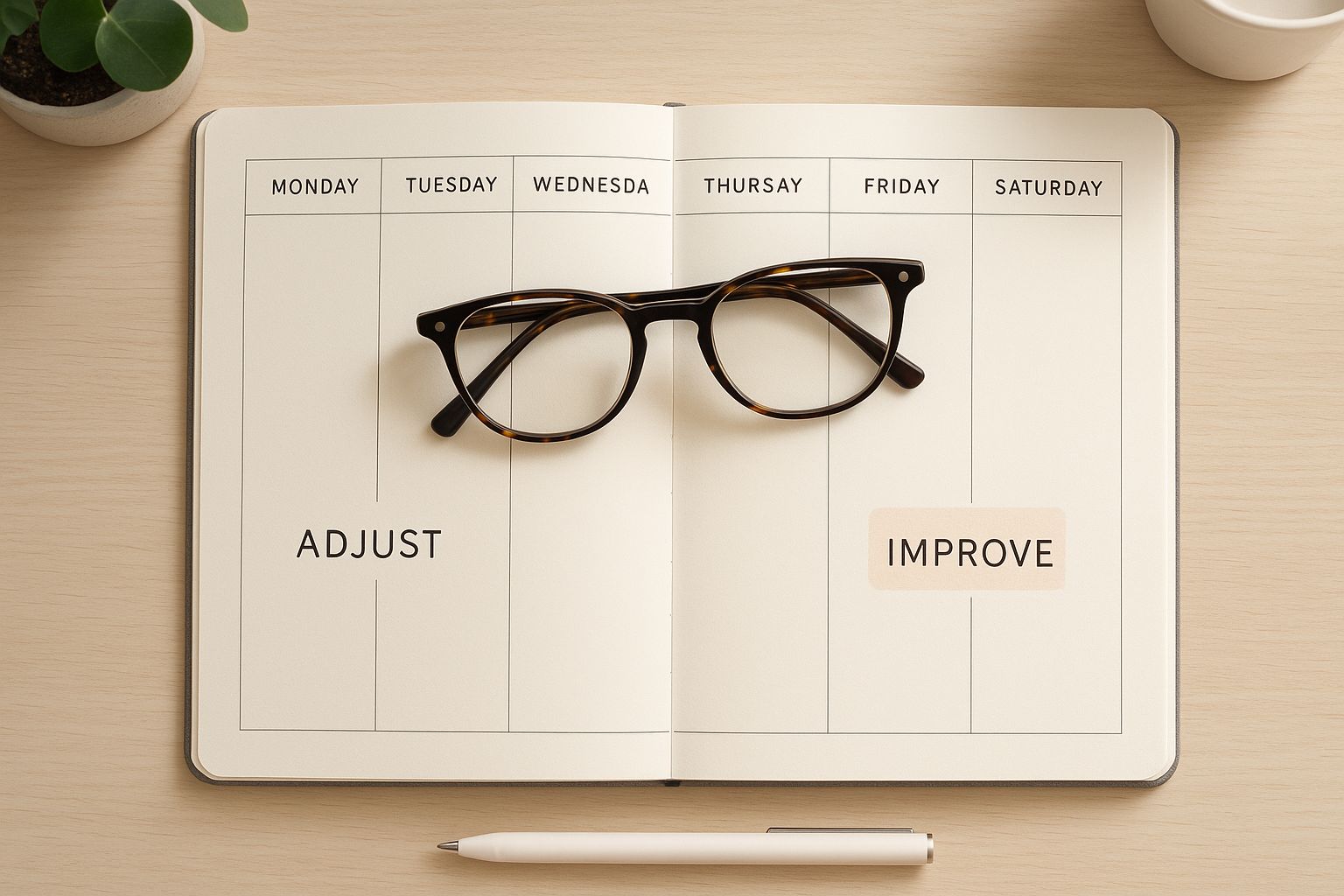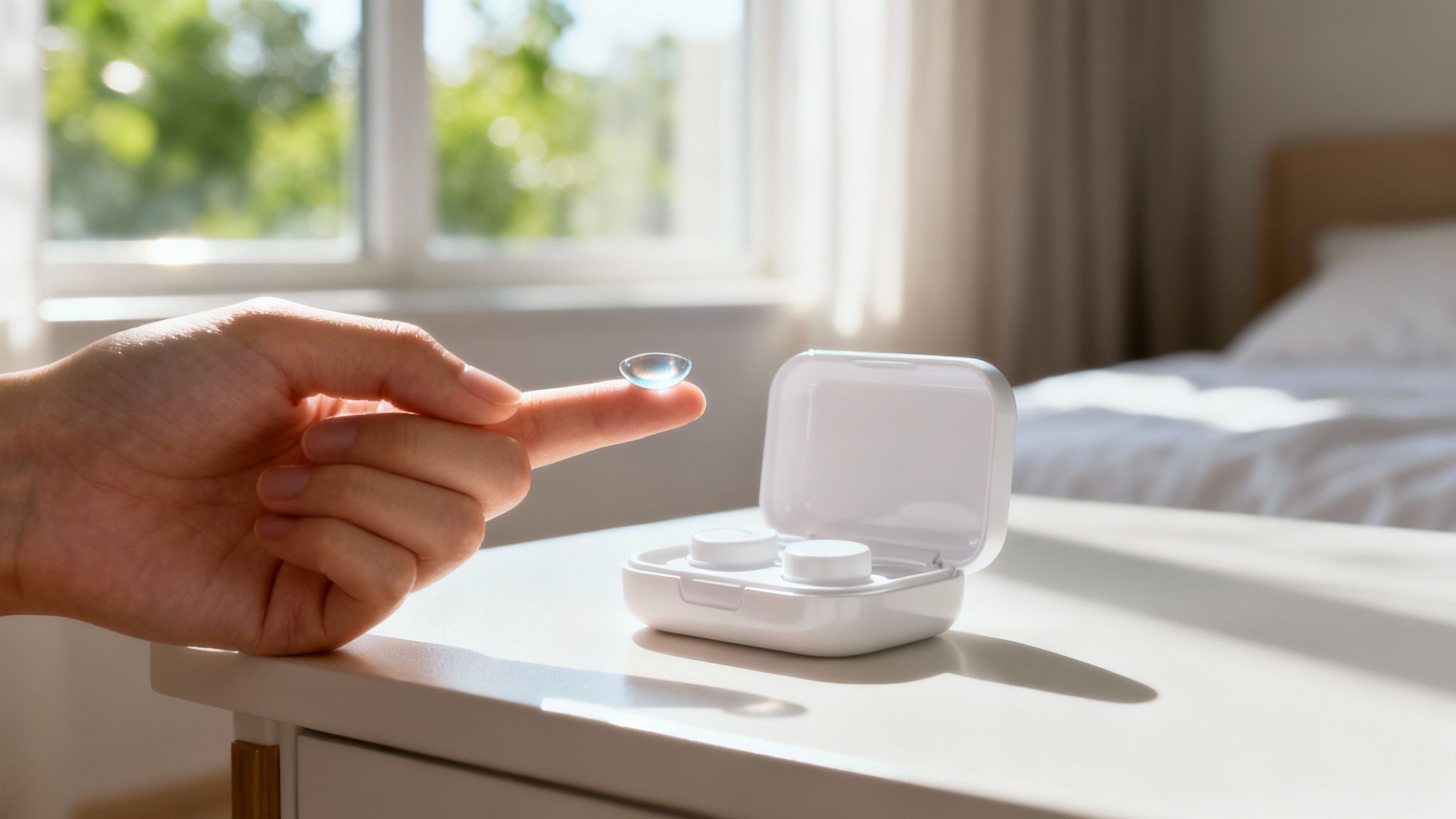Getting a new pair of glasses from your favorite eye doctor in Glendale Heights is an exciting moment. The world is about to snap back into focus! But sometimes, that first look through new lenses can feel a little… strange. This is completely normal.
For most people, it takes anywhere from a few days to two weeks to fully adjust to a new prescription. Think of it as a recalibration period where your brain and eyes are learning to work together in a new way to process all that crisp, new visual information.
Your First Look Through New Lenses
Picking up a new pair of glasses is the start of a short but important adjustment period. Whether this is your very first pair or you’re a seasoned pro upgrading your frames, understanding what’s happening can make the transition to clearer vision much smoother.
This process is all about neuro-adaptation. Essentially, your brain has to re-learn how to interpret the world through its new, improved filter. During this time, it's common to experience a few temporary side effects as your mind gets up to speed.
What To Expect Initially
- Mild Eye Strain or Headaches: Your eye muscles are now working differently to focus, which can cause some temporary fatigue. It's like a new workout for your eyes.
- Altered Depth Perception: Don't be surprised if stairs look a bit steeper or the floor seems slightly tilted. Your brain is just recalibrating its sense of space and distance.
- The "Fishbowl" Effect: You might notice that objects on the edges of your vision appear a little curved or distorted. This is quite common, especially if you have a stronger prescription or have switched to larger frames.
These sensations are temporary and a clear sign that your brain is actively adapting. Of course, having clean lenses is a big part of a smooth adjustment. If you need tips, check out our guide on how to clean your glasses lenses.
Here's a quick look at what you can generally expect as you settle into your new eyewear.
Typical Adjustment Timeline for New Glasses
| Timeframe | Common Sensations | What's Happening |
|---|---|---|
| First 1-3 Days | The most noticeable effects, like mild dizziness, eye strain, and skewed depth perception. | Your brain is in the initial "shock" phase, working hard to process the new, clearer visual signals. |
| First Week | Symptoms begin to fade. Vision feels more natural, though you may still have odd moments. | Neuro-adaptation is well underway. Your brain is building new neural pathways for this new way of seeing. |
| Up to 2 Weeks | Vision should feel comfortable and clear. Any initial side effects are typically gone. | Your brain has fully accepted the new prescription. Wearing your glasses now feels completely normal. |
Remember, this is just a general guide. Everyone's experience is a little different, and several factors can influence how quickly you adapt.
The Week-by-Week Adjustment Timeline
Getting a new pair of glasses is exciting, but it’s more of a process than an instant fix. Think of it as breaking in a new pair of shoes—it takes a little time for things to feel just right. Knowing what to expect week-by-week can make the transition much smoother as your brain and eyes work together to get used to the new view.
During the first couple of days, it's completely normal to feel a bit "off." You might notice some mild eye strain or even a slight headache. This isn't a bad sign; it's actually your brain working hard to process all the crisp, new visual information it's receiving.
By the end of the first week, you should start to feel the initial discomfort fade away. Your vision will begin to seem more natural and less like you’re looking through a new lens. For most people with a simple prescription update, the adjustment is pretty much done within two weeks.
When Adaptation Takes Longer
But what if your prescription is a bit more complex? If you’re getting glasses that correct for astigmatism for the first time, or if you're making the switch to progressive lenses, your brain has a much bigger job to do.
With these more significant vision changes, it's not unusual for the full adjustment period to stretch out to four weeks. Be patient during this time—it’s a crucial learning curve that leads to comfortable, clear vision in the long run. For a deeper dive, check out our guide on adjusting to progressive lenses.
This timeline gives you a good idea of how your brain and eyes gradually get in sync.
As you can see, it's all about gradual improvement. This isn't just anecdotal; research backs it up. One study on vision adaptation found that while only 3.2% of teens felt fully adjusted in two weeks, a much larger group—56.5%—felt comfortable by the three-week mark. Those with astigmatism often needed more than four weeks, showing a direct link between prescription complexity and the time it takes to get used to new glasses.
Your Brain on New Glasses: The Real Adjustment Story
Ever feel a little "off" when you first put on a new pair of glasses? It's a common experience, but what's really happening has less to do with your eyes and more to do with your brain.
Think of it like breaking in a new pair of running shoes. Your feet know how to run, but the new support and shape feel strange at first. Similarly, your brain has to get used to the new, clearer information your eyes are sending. It's an active recalibration process.
This incredible ability is called neuro-adaptation. It's the reason you might temporarily feel like you're in a fishbowl or misjudge the distance to a curb. Your brain is working hard behind the scenes, re-learning spatial relationships and depth perception based on this new, crisper visual data.
It all starts with the incredibly precise measurements from a comprehensive eye exam, which forms the blueprint for your new lenses. If you're curious about what all those numbers mean, our guide on understanding eye prescription numbers is a great place to start.
The Science Behind Neuro-Adaptation
This adaptation isn't just about making blurry things sharp. It involves subtle shifts in how you perceive color, space, and movement. Your brain is essentially updating its internal software.
Scientific studies have shown just how remarkable this process is.
For instance, one study had participants wear glasses that gave everything a reddish tint. Within just a few days, their brains started to compensate, making the world look normal again. What's even more fascinating is that a month after the experiment, about two-thirds (66%) of that adaptation stuck. This proves your brain isn't just making a temporary fix; it's creating new, lasting neural pathways.
This incredible teamwork between your eyes, brain, and your new prescription is what allows you to see the world clearly. Whether you're driving, reading, or just enjoying the view, your brain is the unsung hero making it all happen seamlessly.
What Affects Your Adjustment Time?
Ever wondered why your friend pops on a new pair of glasses and is good to go, while you feel like you're walking around in a fishbowl for a few days? It's a common experience, and the truth is, everyone's adjustment period is a little different. A few key things really shape how long it takes to feel completely comfortable.
Your prescription is the biggest player here. If you're just getting a minor tweak to a simple prescription, you might feel right at home in a day or two. But if it’s a big jump in strength, or you’re correcting for astigmatism for the first time, you can definitely expect a longer “getting-to-know-you” period with your new specs.
Lenses and Frames Make a Difference
The kind of lenses you get matters, too. For instance, progressive lenses are fantastic—they pack multiple prescriptions into one seamless lens—but they have a notorious learning curve compared to simple single-vision lenses. It just takes your brain a bit more time to learn how to look through the right part of the lens for different distances.
To get a better handle on all the options out there, our guide on the different types of eyeglass lenses is a great place to start.
Even the frames you pick can change things! Making a big switch from a small, barely-there frame to a bold, oversized style can mess with your peripheral vision. Your brain has to get used to seeing those new frames in the edges of your sight, and that takes a little time.
Think of it this way: your journey to clear vision is a unique mix of your eyes, your brain, and your eyewear. Your age and whether this is your very first pair of glasses also play a surprisingly big role.
It's Also Just… You
Beyond the hardware of your glasses, your brain’s own wiring is a huge variable. Some of us are just naturally more sensitive to visual changes.
In fact, one experiment gave people the exact same distorting lenses and found that how quickly and how well they adapted was all over the map. This really drives home that personal, stable differences in how we each perceive the world are a major factor. You can read the research on individual adaptation for yourself if you're curious.
This is exactly why getting personalized advice from an optometrist who knows your history is so crucial. They can help make sure your transition to new eyewear is as smooth and comfortable as possible.
Simple Tips to Help You Adjust Faster
Getting your brain and eyes on the same page doesn't have to be a struggle. Think of it like breaking in a new pair of shoes—a few simple, consistent habits can make all the difference, helping you settle into your new glasses comfortably and quickly.
The absolute best thing you can do? Be consistent. Make a point to wear your new glasses as much as possible, especially first thing in the morning when your eyes are rested. This gives your brain a clean, steady stream of visual information to work with.
Make a Routine and Stick With It
When your new vision feels a little "off," it’s so tempting to grab your old, comfortable pair. Try to fight that urge. Switching back and forth is like hitting the reset button on your brain's adjustment process, which only confuses it and drags things out.
Here are a few practical things you can do to speed things along:
- Go All In: The more you wear your new glasses, the faster your brain adapts. Put them on when you wake up and keep them on.
- Get the Fit Just Right: Are your frames constantly slipping down your nose? That small slide can shift the optical center of your lenses, forcing your eyes to work harder. We can adjust your frames to make sure they sit perfectly.
- Start at Home: Give your new glasses a test run in a familiar, low-stakes environment like your house. Once you feel more grounded, you’ll be ready for more complex visual tasks, like driving down North Avenue or navigating a busy sidewalk near Glendale Lakes Golf Club.
Think of it this way: you want to give your brain a clear signal, not mixed messages. Committing to your new glasses provides the consistent input needed to recalibrate your vision and get you seeing clearly.
By following these simple steps, you’re actively helping your brain adapt. It’s a small investment of patience that pays off with the crisp, clear vision you'll get from your new designer eyeglasses from our Glendale Heights boutique. It’s all about helping your vision system embrace the change.
When It's Time to Call Your Glendale Heights Eye Doctor
It's one thing to have a few days of that "new glasses" feeling, but it's another thing entirely when the adjustment period drags on. Your comfort is the whole point, so you should never feel like you have to just "tough it out."
If you’ve been wearing your glasses consistently for two full weeks and you're still dealing with nagging headaches, serious dizziness, or constant eye strain, that's a sign something isn't quite right. Give us a call.
Often, the fix is surprisingly simple. Your prescription might be perfect, but the way the frames sit on your face could be off, misaligning the optical center of the lenses. A quick frame adjustment can make a world of difference. Other times, a quick re-check of the prescription measurements is all it takes.
Your vision should feel effortless and clear. If your adjustment feels more like a struggle than a smooth transition, please don't hesitate to reach out. We're here to make sure your new view of the world is exactly as it should be.
For our neighbors with persistent issues, we recommend scheduling one of our detailed eye exams in Glendale Heights. The iDoctor team will get to the bottom of it and ensure your new eyewear is a perfect match.
FAQ: Getting Used to Your New Glasses
It's completely normal to have questions when you first get a new pair of glasses. Here are a few of the most common ones we hear from our patients at iDoctor in Glendale Heights.
Do I need an appointment to look at your Cartier and Gucci glasses?
You don't need an appointment to browse our curated collection of luxury eyewear! Feel free to stop by our Glendale Heights boutique any time to explore our frames from Cartier, Gucci, Tom Ford, and other top designers. If you decide to make a purchase, we'll ensure a perfect fit.
Is it normal to feel dizzy with new glasses?
Yes, it absolutely is. A little dizziness or feeling slightly off-balance is one of the most common things people experience. This is especially true if you've had a big jump in your prescription or if you're trying progressive lenses for the first time. That feeling of disorientation is just your brain recalibrating, and it almost always fades away within a few days to a week.
Do you accept VSP or EyeMed insurance?
Yes, we proudly accept all major vision insurance plans, including VSP and EyeMed. Our team is happy to help you understand and maximize your benefits for everything from your eye exam to your new designer eyeglasses.
Why does everything look warped on the sides?
This is often called the "fishbowl effect," and it's a classic sign your brain is adapting to a new prescription, frame shape, or lens type. You're simply noticing the new curves at the edge of your glasses, which can make your peripheral vision seem a bit distorted. Your brain is incredibly good at tuning this out, and before you know it, it will learn to ignore that distortion completely. The key is to keep wearing them.
Your vision and comfort are what matter most. If you're still struggling after two weeks, or if something just doesn't feel right, please don't hesitate to schedule a follow-up.
Give our Glendale Heights boutique a call or visit iDoctor online to get the help you need. As the best optometrist in Glendale Heights, we are committed to ensuring you love your new glasses. You can find more information at https://idoctoril.com.








